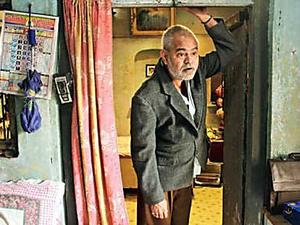pachchanaaku kalaIN
Artists across age groups celebrate women’s March with striking portrayals on being a woman
What happens when artists in their 20s and 30s present their observations on women? They explore dimensions different from that of the more established, senior artists. ‘Being in her shoes’ at Kalakriti presents snapshots of this changing phase of art.
Faiza Fatima Hasan’s work is a mix of embroidery and watercolours. ‘Haath Lagake Toh Dekho’ she urges at a corner table that has a circular embroidery frame with a stitched lotus and the stem designed with golden safety pins. A copy of ‘The Portrait of a Lady’ by Henry James lies next to the frame. Faiza, who graduated from University of Hyderabad in 2014, says she combined her interest in embroidery and watercolours. “The visual is, for me, a starting point,” she says. The portraits of women are as important to her as a splatter of blood in the corner of a frame. Her art touches upon domesticity, for which embroidery is symbolic, and violence against women is conveyed through needles pierced on to the canvas. “At first, I was terrified to embroider on a canvas thinking I’d end up spoiling the painting,” she says.
Priyanka Aelay also uses circular frames, two at a time, to express her thoughts on wildlife and birds. Afza Tamkanath’s life-like paintings hold a mirror to women in Hyderabad. On a large canvas, she paints women that inhabit a city like Hyderabad — burqa-clad women, denim and tee-clad young mother with a child in a stroller, youngsters walking in tees, shrugs, skirts and shorts, young couples — just about everyone we are likely to come across.
The ideas explored and the medium used by these emerging artists is a study in itself. P.S. Jalaja from Kerala paints a large canvas ‘Tug of the war’ illustrating men and women across the world at war for varied reasons and the children bearing the cross of the war. Vinita Dasgupta uses pearls and beads of different colours, sizes and shapes to talk about women in works inspired by Gotipua dancers. Prajakta Palav’s paintings are palm-sized gauche on paper floating images.
The iconoclasts
‘Celebrating the Feminine’ which will open at Shrishti on March 14, will have nine established women artists — Anjoli Ela Menon, Arpana Caur, Gogi Saroj Pal, Kavitha Deuskar, Lalita Lajmi, Rini Dhumal, Rekha Rodwittiya and Seema Kohli — depicting their thoughts on women. “Art has offered an equal playing field for women,” says curator Lakshmi Nambiar, who chose the paintings based on women artists she admires and how they represent womanhood. “All of them have portrayed strong sentiments about being a woman. For instance, Nalini Malani shows a woman in a plastic bag, which can be inferred in different ways. Gogi Saroj Pal decided to be an artist when she was young, in the 50s or 60s, when it wasn’t common to choose art. Arpana Caur, besides being an artist and a mother, runs a school that offers vocational training for girls. Each of them is doing a balancing act between work and home,” she points out. ‘Celebrating the Feminine’ also features younger artists, for instance Rekha Rodwittiya, who portrays issues related to women.
Installations
‘Born A Girl’, scheduled to open on March 13 at Goethe Zentrum, will have installations and new media art by 15 artists, curated by Avani Rao Gandra for Art For Change, an initiative by Iconart gallery. The participating artists are Anindita Chakraborty, Appala Naidu, Archana R. Biswas, Avani Rao Gandra, Debosmita Samanta, Farzona Khannoon, Glower Paul, Pavan Kumar D, Ravi Kumar Nayak, P.C. Prasad, Sai Sheela, Sayoni Laha, Sharmistha Kar, Sonali Laha and Tapasi Nath.Artists express their thoughts pertaining to violence that begins in the womb resulting in female foeticide, disparities while growing up, child labour, early marriages and teenage pregnancies, physical abuse and violence in subtle and not-so-subtle manners, underlining why women have the right to live and die in peace. “The craftsmanship I’ve seen in women artists is commendable,” says curator Avani. “Draupadi vastraharan is symbolic of rape; a pregnant form with heavy rocks hanging from the womb shows the pressure a female form faces; there’s a self-destructing sculpture made of clay. We also show the cheery side of being a woman,” she adds.
Meanwhile, Ailamma art gallery also has both men and women artists celebrating women. Eleven artists namely Aparna P, Jackie Lima, Kappari Kishan, Nagamani, Padmashali Durga Rao, Piu Mahapatra, Rebeca Dorich, Shahenaz Sultana, Sravanti Juluri, Vasanta Mukthavaram and Vineela Pamula focus on violence, objectification and discrimination in everyday life.














Please Email the Editor